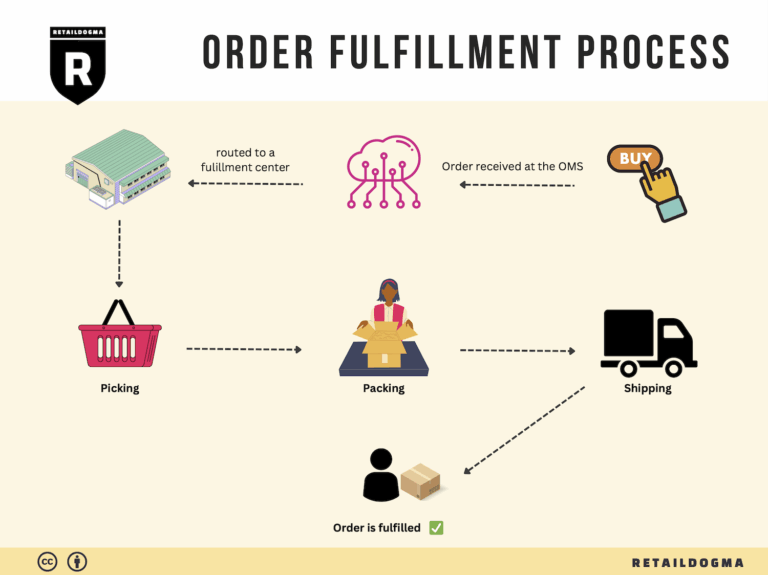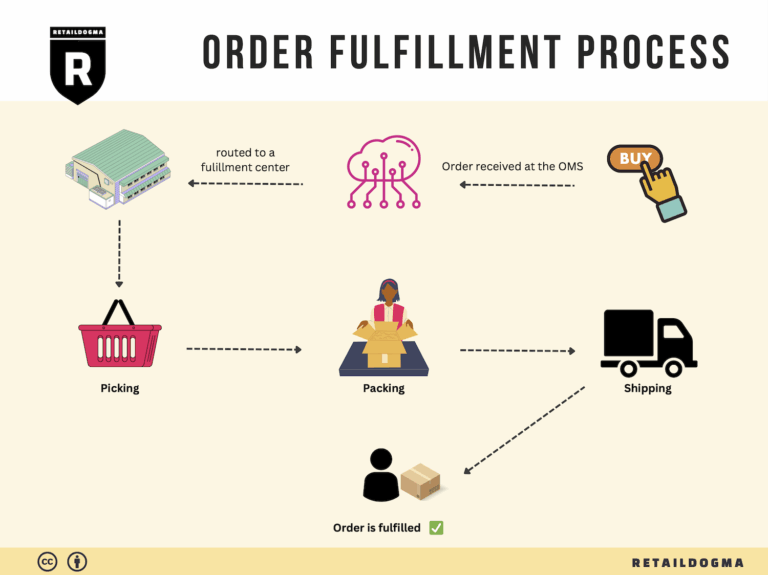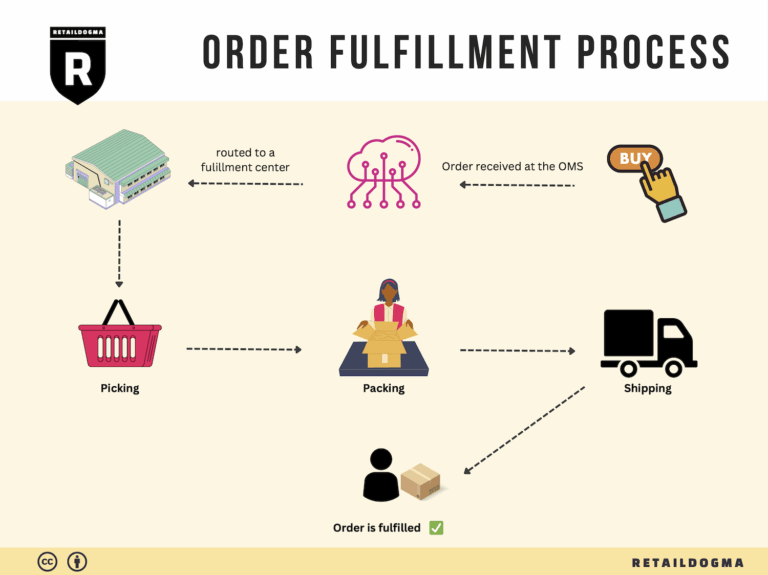How Order Fulfillment Works: A Step-by-Step Guide for Businesses
What is E-commerce Fulfillment? An Introduction for Growing Businesses
Understanding E-commerce Fulfillment
As an e-commerce business owner, the excitement of growing sales can quickly turn into a daunting challenge when faced with the logistics of packing and shipping orders. The joy of receiving customer orders can be overshadowed by the complexities of getting products into the hands of satisfied buyers. Whether it’s managing inventory, coordinating shipping logistics, or ensuring timely deliveries, the fulfillment process can become overwhelming, especially as your business scales.
At its core, e-commerce fulfillment is the process of getting a product from your inventory to the customer. This encompasses everything from order processing and picking items from the warehouse to packing them securely and shipping them out. As your sales increase, the need for a streamlined and efficient fulfillment strategy becomes critical. This guide aims to demystify the various aspects of e-commerce fulfillment, making it easier for you to navigate the complexities and find the right solutions for your growing business.
Throughout this guide, we will explore different fulfillment models, including Third-Party Logistics (3PL) and Fulfillment by Amazon (FBA). Understanding these options will help you determine which model best fits your business needs and customer expectations. We will also delve into the core services offered by fulfillment providers, such as inventory management, shipping, return processing, and kitting services.
Choosing the right fulfillment partner is a pivotal decision that can significantly impact your operational efficiency and customer satisfaction. We will provide practical tips on how to evaluate potential partners based on their capabilities, technology, and customer service. Additionally, we will discuss pricing structures, helping you to understand the costs associated with various fulfillment services and how to select a solution that aligns with your budget.
The goal of this guide is to empower you with the knowledge and tools needed to make informed decisions about your logistics strategy. By understanding the ins and outs of e-commerce fulfillment, you can focus on what you do best—growing your business and delighting your customers. Whether you are a startup or an established brand, this guide will serve as a valuable resource as you scale your operations and streamline your fulfillment process.
What You’ll Learn In This Guide
- What is E-commerce Fulfillment? An Introduction for Growing Businesses
- The Order Fulfillment Process: From ‘Buy’ Button to Customer’s Door
- Comparing Fulfillment Models: In-House vs. 3PL vs. Dropshipping
- A Deep Dive into Amazon FBA: Pros, Cons, and Who It’s For
- Core Services Offered by Fulfillment Centers
- How to Choose a Fulfillment Partner: A 6-Point Checklist
- Understanding Fulfillment Pricing: A Breakdown of Common Fees
- Frequently Asked Questions (FAQs) about Fulfillment
- Conclusion: Is Outsourcing Fulfillment the Right Move for Your Business?
- Important Disclaimer
The Order Fulfillment Process: From ‘Buy’ Button to Customer’s Door
1. Receiving Inventory
The order fulfillment process begins with receiving inventory from suppliers or manufacturers. This step involves checking the incoming shipments against purchase orders to ensure that the correct quantities and products have been delivered. Each product is assigned a Stock Keeping Unit (SKU), which is a unique identifier that simplifies tracking and management.
Importance: Accurate receiving is crucial because it establishes the baseline for inventory levels. Any discrepancies—such as missing items or incorrect shipments—can lead to stockouts or overstock situations, both of which can negatively impact sales and customer satisfaction.
Key Term: SKU (Stock Keeping Unit) – A unique identifier for each product, essential for tracking inventory levels and facilitating efficient management.
2. Warehouse Storage
Once the inventory is received and verified, it is stored in a designated warehouse area. Effective warehousing practices involve organizing products in a manner that maximizes space and simplifies retrieval. This can include using pallet racks, shelving units, or bins, depending on the nature of the products.
Importance: Proper storage not only optimizes space but also ensures that items are easily accessible for order fulfillment. A well-organized warehouse reduces the time spent searching for products, which can enhance operational efficiency and speed up the overall fulfillment process.
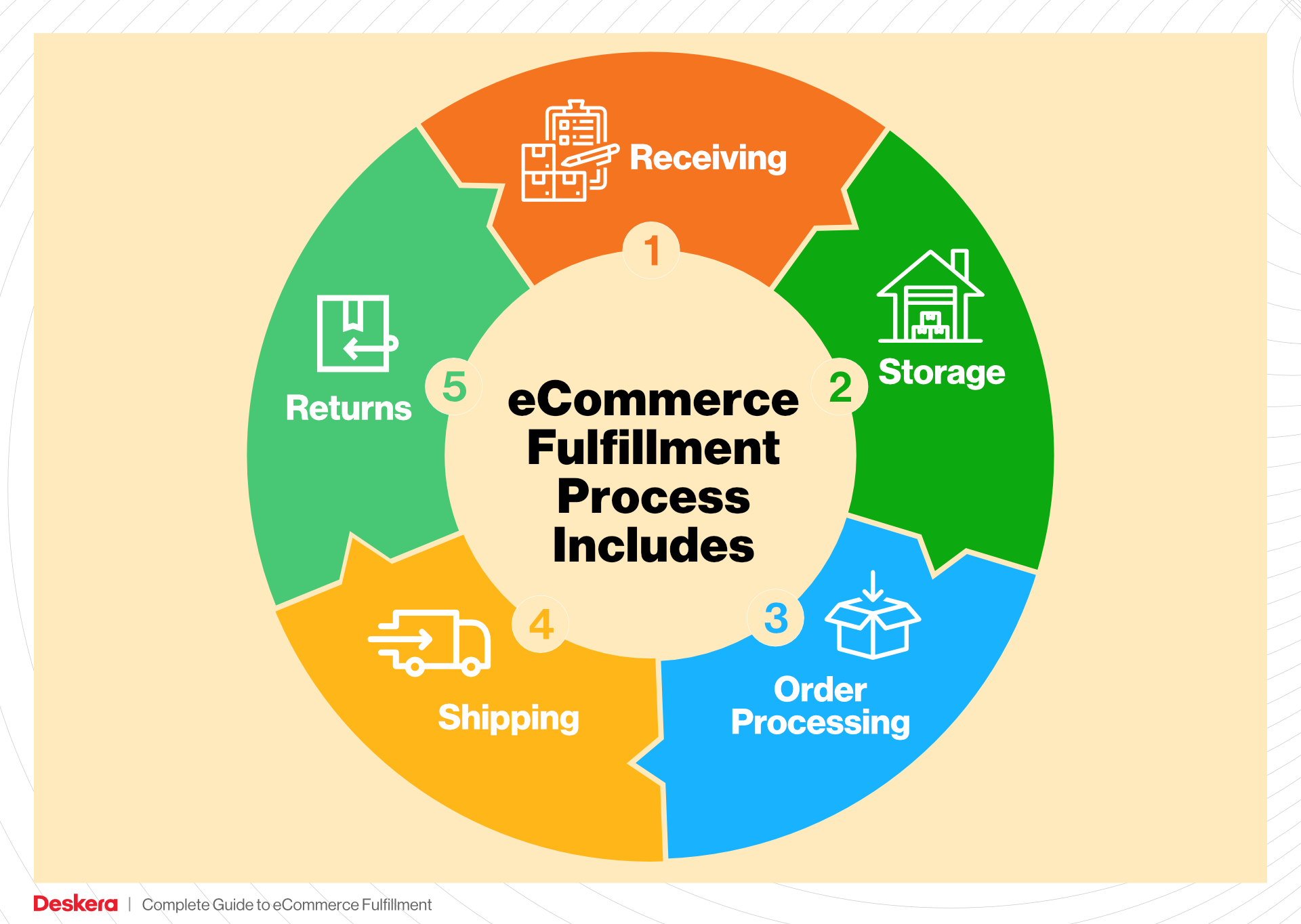
Key Term: FIFO (First In, First Out) – A common inventory management principle ensuring that older stock is sold before newer stock, reducing the risk of obsolescence and waste.
3. Order Picking
When a customer places an order, the next step is order picking, where warehouse staff locate and retrieve the items from storage. This process often utilizes pick lists, which are detailed documents that specify the items and quantities needed for each order. Depending on the fulfillment center’s size, order picking can be performed in various ways, including single order picking or batch picking for multiple orders at once.
Importance: Efficient order picking is vital for meeting customer expectations regarding delivery speed and accuracy. Mistakes in this step can lead to incorrect orders being shipped, which can harm customer satisfaction and increase return rates.
Key Term: Pick List – A document or digital tool that outlines the items and quantities needed to fulfill a customer order, guiding warehouse staff during the picking process.
4. Order Packing
After the items have been picked, they are taken to the packing station, where they are prepared for shipment. This step includes checking the items for quality, packing them securely in appropriate boxes, and adding any branding materials or invoices. Careful packing helps prevent damage during transit and can enhance the unboxing experience for customers.
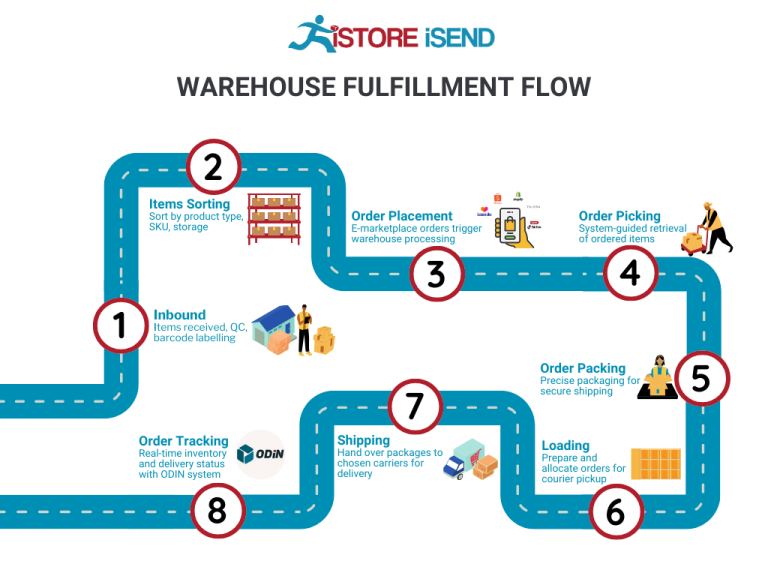
Importance: Packing is not just about protecting the product; it’s also a branding opportunity. A well-packaged order can leave a lasting impression on customers and encourage repeat business. Efficient packing processes can also reduce shipping costs by optimizing the use of space in shipping containers.
Key Term: Packing Slip – A document included in the package that lists the items included in the shipment, providing clarity for the customer and serving as a reference for returns.
5. Shipping & Delivery
The final step in the order fulfillment process is shipping and delivery. Once the order is packed, it is handed over to a shipping carrier for delivery to the customer. Businesses typically choose from various carriers (e.g., USPS, FedEx, UPS) based on factors such as cost, speed, and reliability. Real-time tracking systems allow both the business and the customer to monitor the shipment’s progress until it reaches its final destination.
Importance: Timely and accurate shipping is critical for customer satisfaction. Delays or issues during this stage can lead to customer frustration and potentially damage the business’s reputation. Additionally, effective shipping strategies can significantly reduce costs and improve margins.
Key Term: Tracking Number – A unique identifier assigned to each shipment that allows customers and businesses to track the package’s journey from the fulfillment center to the delivery address.
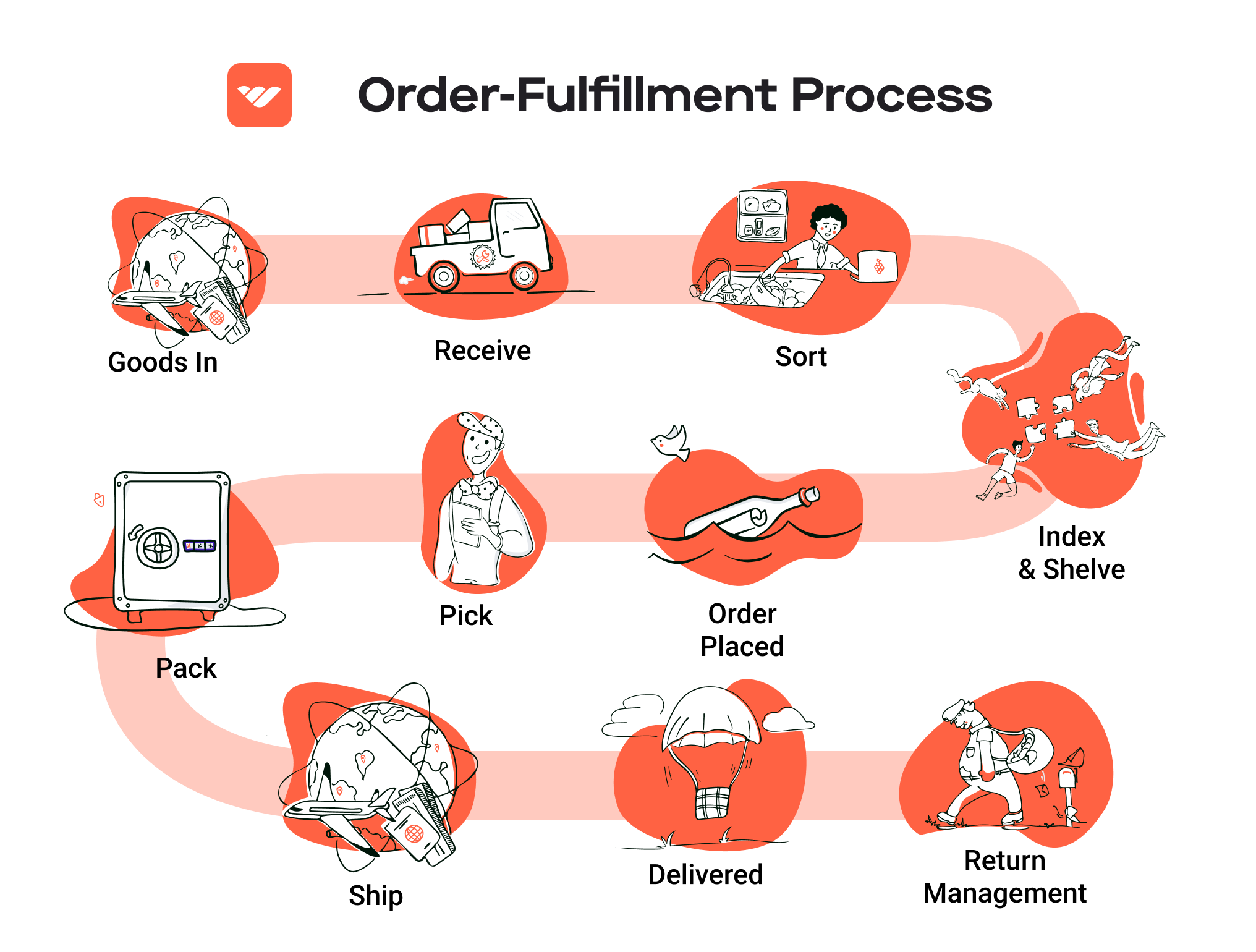
By understanding and optimizing each of these five steps, e-commerce businesses can enhance their order fulfillment processes, improve customer satisfaction, and ultimately scale their operations effectively.
Comparing Fulfillment Models: In-House vs. 3PL vs. Dropshipping
Fulfillment Model Comparison
| Model | Who Handles Inventory | Best For (Business Stage) | Key Advantage | Key Disadvantage |
|---|---|---|---|---|
| In-House Fulfillment | The business itself | Established businesses | Full control over inventory and processes | High overhead costs and resource demands |
| Third-Party Logistics (3PL) | 3PL provider | Start-ups to mid-sized businesses | Scalability and reduced operational burden | Potential loss of control and dependency |
| Dropshipping | Supplier | New businesses and entrepreneurs | Low startup costs and minimal risk | Lower profit margins and reliance on suppliers |
In-House Fulfillment
In-house fulfillment involves managing the entire logistics process within the business itself. This model is typically adopted by established businesses that have the resources and capacity to maintain control over their inventory, warehousing, and shipping processes. Companies utilizing in-house fulfillment can tailor their operations to match their specific needs, ensuring complete oversight of inventory management, order processing, and customer service. This control allows for customized packaging, branding, and quality assurance, which can enhance customer satisfaction. However, this model requires significant investment in infrastructure, including warehousing, staffing, and technology. As a result, businesses may face high overhead costs and resource demands, making this model less viable for startups or those with fluctuating order volumes.
Third-Party Logistics (3PL)
Third-party logistics (3PL) providers offer a flexible and scalable solution for businesses looking to outsource their fulfillment needs. This model is well-suited for startups and mid-sized companies that wish to focus on core business functions while leveraging the expertise and infrastructure of a 3PL partner. By outsourcing fulfillment to a specialist, businesses can benefit from reduced operational burdens, lower shipping costs, and faster order processing. 3PL providers typically have established relationships with carriers, allowing for competitive shipping rates and access to advanced logistics technologies. However, businesses must navigate the potential loss of control over inventory and the reliance on an external partner. It’s crucial to choose a reputable 3PL that aligns with the company’s values and standards to mitigate risks associated with service quality and responsiveness.
Dropshipping
Dropshipping is an increasingly popular fulfillment model for new businesses and entrepreneurs looking to minimize startup costs and reduce risk. In this model, the retailer does not hold inventory but instead relies on suppliers to ship products directly to customers upon order. This approach allows businesses to launch with minimal capital investment since there are no upfront costs for inventory. It also enables entrepreneurs to experiment with a wide range of products without the financial burden of purchasing stock. However, dropshipping has its challenges; profit margins can be lower compared to other models due to reliance on suppliers, and businesses may have limited control over product quality and shipping times. Additionally, customer service can become complicated if issues arise with suppliers, making it essential for businesses to establish strong relationships with reliable vendors to ensure a smooth operation.
Conclusion
When considering a fulfillment model, it is vital for e-commerce business owners and operations managers to assess their specific needs, business stage, and long-term goals. In-house fulfillment offers complete control but at a higher cost, making it ideal for established businesses. Third-party logistics provide a balance of flexibility and scalability, suitable for growing companies. Dropshipping presents a low-risk entry point for new businesses, but it comes with challenges related to profit margins and supplier reliability. Each model has its unique advantages and disadvantages, and the choice ultimately depends on the company’s operational capacity, financial resources, and strategic objectives. By carefully evaluating these factors, businesses can select the fulfillment model that best supports their growth and enhances customer satisfaction.
A Deep Dive into Amazon FBA: Pros, Cons, and Who It’s For
Understanding Fulfillment by Amazon (FBA)
Fulfillment by Amazon (FBA) is a service provided by Amazon that allows sellers to store their products in Amazon’s fulfillment centers. Amazon takes care of storage, packaging, shipping, and customer service for these products. This service enables sellers to leverage Amazon’s extensive logistics network, providing a seamless shopping experience for customers.
How FBA Works
-
Setup: Sellers sign up for FBA through their Amazon Seller Central account. They can then create product listings and specify which items they want to fulfill through Amazon.
-
Shipping Inventory: Sellers send their products to Amazon’s fulfillment centers. Amazon provides guidelines on how to prepare and package products to ensure they arrive in good condition.
-
Storage: Once products arrive at Amazon, they are stored until sold. Sellers are charged storage fees based on the amount of space their inventory occupies.
-
Order Processing: When a customer orders a product, Amazon picks, packs, and ships the item directly to the customer. This process is automated and optimized for efficiency.
-
Customer Service: Amazon also handles customer inquiries and returns for FBA orders, providing a level of service that can enhance customer satisfaction.
-
Payment: After the sale, Amazon deducts fees for the service and deposits the remaining funds into the seller’s account.
Pros of Fulfillment by Amazon
Prime Eligibility
One of the most significant advantages of FBA is that products become eligible for Amazon Prime. This means that Prime members can benefit from free two-day shipping, which significantly enhances the product’s visibility and attractiveness. Prime eligibility can lead to higher conversion rates, as many customers filter their searches to show only Prime-eligible items.
Customer Trust
Customers trust Amazon for its reliable delivery and customer service. By using FBA, sellers can capitalize on this trust. Products fulfilled by Amazon are often perceived as more reliable, leading to higher sales and positive reviews. Moreover, Amazon’s customer service handles inquiries and issues on behalf of the seller, further enhancing customer satisfaction.
Multi-Channel Fulfillment
FBA is not limited to sales on Amazon alone. Sellers can use FBA to fulfill orders from their own websites or other marketplaces. This flexibility allows businesses to centralize their logistics while still reaching customers across multiple platforms.
Cons of Fulfillment by Amazon
High Fees
While FBA offers many benefits, it comes at a cost. Sellers must pay various fees, including storage fees and fulfillment fees. These costs can add up, particularly for businesses with low-margin products or seasonal inventory that may not sell quickly. It’s crucial for sellers to analyze their pricing strategy to ensure profitability after FBA fees are accounted for.
Strict Inventory Rules
Amazon has stringent inventory management policies. Sellers must adhere to guidelines regarding product preparation, packaging, and labeling. Failure to comply can result in additional fees or, in severe cases, the removal of inventory from Amazon’s warehouses. This can be particularly challenging for new sellers who may not be familiar with Amazon’s requirements.
Commingling Risks
FBA operates on a commingling system, which means that the inventory of multiple sellers can be stored together in the same fulfillment center. While this can optimize storage space and reduce costs, it also introduces risks. For example, if a customer receives a defective product from another seller, it can negatively impact the original seller’s reviews and reputation. Sellers must weigh this risk against the benefits of using FBA.
Who is FBA Best For?
Fulfillment by Amazon is particularly well-suited for:
-
Established Sellers: Businesses that have already built a brand and customer base and are looking to expand their reach can benefit from the logistics and customer service support that FBA offers.
-
High-Volume Sellers: Sellers with significant sales volume can leverage FBA’s shipping capabilities to improve order processing times and customer satisfaction. The economies of scale can also help offset the costs associated with FBA.
-
Product Categories with High Turnover: Sellers with products that have a high turnover rate can effectively utilize FBA to manage inventory and fulfillment costs. The faster products move, the less impact FBA fees will have on profitability.
-
Multi-Channel Sellers: Businesses that sell on multiple platforms (like eBay, Shopify, or their own website) can streamline their fulfillment processes by using FBA for all orders, simplifying logistics and inventory management.
-
New Entrepreneurs: For those new to e-commerce, FBA provides an opportunity to enter the market without needing to establish their own fulfillment infrastructure. This allows them to focus on product development and marketing while Amazon handles logistics.
In conclusion, Fulfillment by Amazon offers a robust solution for e-commerce sellers looking to leverage Amazon’s vast resources. However, it’s essential for businesses to carefully evaluate the associated costs and rules to determine if FBA aligns with their operational goals and product strategies.
Core Services Offered by Fulfillment Centers
Inventory Management & Warehousing
Inventory management and warehousing are foundational services provided by fulfillment centers that play a critical role in the success of e-commerce businesses. This service involves the systematic tracking and storage of products in a secure facility, ensuring that stock levels are maintained efficiently and effectively.
One of the primary benefits of effective inventory management is the ability to minimize carrying costs. By leveraging real-time tracking systems, fulfillment centers can provide e-commerce businesses with insights into stock levels, sales trends, and reorder points. This information allows businesses to make informed decisions about when to restock, reducing the risk of overstocking or stockouts.
Moreover, secure warehousing facilities offer a safe environment for inventory, protecting it from damage or loss. Many fulfillment centers also provide flexible storage options without long-term commitments, which is especially beneficial for seasonal businesses or those experiencing rapid growth. The combination of efficient inventory management and reliable warehousing enables e-commerce businesses to focus on scaling their operations rather than worrying about logistics.
Pick and Pack Services
Pick and pack services are a critical component of the fulfillment process, ensuring that orders are accurately assembled and shipped to customers in a timely manner. This service involves selecting (picking) the right products from the warehouse, packing them securely for shipment, and preparing them for delivery.
The benefits of efficient pick and pack services are manifold. First, they significantly enhance order accuracy, which is essential for customer satisfaction. A high order accuracy rate reduces the likelihood of returns and increases customer loyalty, as clients receive exactly what they ordered.
Additionally, a streamlined pick and pack process can lead to faster shipping times. Fulfillment centers utilize advanced technology and experienced staff to ensure that orders are processed swiftly, meaning that e-commerce businesses can meet customer expectations for quick delivery. This capability is particularly crucial in today’s competitive e-commerce landscape, where customers often expect same-day or next-day shipping.
Kitting and Assembly
Kitting and assembly services provided by fulfillment centers involve the pre-assembly of products into ready-to-ship kits or bundles. This can include anything from assembling promotional packages to creating multi-item bundles that customers can purchase as a single unit.
The primary benefit of kitting and assembly is the enhancement of product value and appeal. By offering products in curated kits, e-commerce businesses can increase average order value and attract customers looking for convenience. For example, a beauty brand might offer a skincare kit that includes multiple products, encouraging customers to buy more than they initially intended.
Moreover, kitting can also streamline inventory management. By consolidating multiple items into a single SKU, businesses can simplify their inventory tracking and reduce the complexity of their stock-keeping processes. This efficiency not only saves time but also minimizes the potential for errors in order fulfillment.
Returns Management (Reverse Logistics)
Returns management, also known as reverse logistics, is an essential service that addresses the inevitable reality of e-commerce: returns. Fulfillment centers handle the entire returns process, from receiving returned items to inspecting, restocking, and managing inventory adjustments.
Effective returns management provides several benefits to e-commerce businesses. First, it enhances customer satisfaction by ensuring that the returns process is smooth and hassle-free. A well-managed returns process can turn a negative experience into a positive one, encouraging customers to shop again despite their initial disappointment.
Additionally, efficient returns management allows businesses to quickly reintegrate returned items back into inventory, minimizing losses. Fulfillment centers often employ advanced tracking systems that provide real-time updates on the status of returns, allowing businesses to maintain accurate inventory levels and make informed decisions regarding restocking.
In conclusion, the core services offered by fulfillment centers—inventory management and warehousing, pick and pack services, kitting and assembly, and returns management—are integral to the success of e-commerce businesses. By partnering with a reliable fulfillment center, e-commerce owners can streamline their operations, enhance customer satisfaction, and ultimately scale their businesses with confidence.
How to Choose a Fulfillment Partner: A 6-Point Checklist
Location & Warehouse Network
Why It Matters:
The geographical location of your fulfillment partner’s warehouses can significantly impact shipping times and costs. A fulfillment center that is strategically located close to your target customers can reduce shipping expenses and improve delivery speeds, which is crucial for customer satisfaction.
Questions to Ask:
– Where are your fulfillment centers located, and how do these locations align with my customer base?
– What is your average shipping time to my target regions?
– Do you have plans for expanding your warehouse network, and if so, where?
Technology & Integrations
Why It Matters:
In today’s e-commerce landscape, technology plays a vital role in order management, inventory tracking, and shipping logistics. A partner that offers robust technology solutions can streamline operations and provide you with real-time data to make informed decisions.
Questions to Ask:
– What order management system do you use, and how does it integrate with my e-commerce platform?
– Can you provide real-time inventory tracking and reporting?
– What APIs or integration options do you offer for my existing systems?
Specializations (e.g., cold storage, oversized items)
Why It Matters:
Not all fulfillment centers are equipped to handle specific types of products. If your business deals with perishable goods, oversized items, or fragile products, it’s crucial to partner with a fulfillment provider that has the necessary expertise and facilities.
Questions to Ask:
– Do you have specialized facilities for my type of products (e.g., cold storage, heavy items)?
– What safety and handling protocols do you have in place for sensitive products?
– Can you accommodate unique packaging or kitting requirements?
Scalability & Capacity
Why It Matters:
As your business grows, your fulfillment needs will likely change. It’s important to partner with a provider that can scale operations to meet increased demand without compromising service quality. Assessing their capacity and flexibility is key to ensuring long-term compatibility.
Questions to Ask:
– What is your current capacity, and how do you handle peak seasons or unexpected spikes in demand?
– Do you have a clear process for scaling up operations if my order volume increases?
– Are there any limits to the types of products or volume you can handle?
Pricing and Contracts
Why It Matters:
Understanding the pricing structure and contract terms of a fulfillment partner is essential for budgeting and financial planning. Hidden fees can quickly erode profit margins, so clarity and transparency are paramount.
Questions to Ask:
– What is your pricing model (e.g., per order, per item, monthly fees)?
– Are there any additional fees I should be aware of (e.g., setup fees, storage fees, integration fees)?
– What are the terms of your contracts, and is there flexibility to adjust them as my business needs change?
Customer Support & Reviews
Why It Matters:
Reliable customer support can make or break your relationship with a fulfillment partner. A responsive support team can resolve issues quickly, minimizing disruptions in your operations. Additionally, reviewing customer feedback can provide insights into the partner’s reliability and service quality.
Questions to Ask:
– What type of customer support do you offer (e.g., dedicated account manager, 24/7 support)?
– How do you handle issues that arise during the fulfillment process?
– Can you provide references or case studies from similar businesses that have worked with you?
Final Thoughts
Choosing the right fulfillment partner is a critical decision that can impact your e-commerce business’s efficiency and customer satisfaction. By following this checklist, you can evaluate potential partners based on essential criteria that align with your operational needs and growth ambitions. Take the time to conduct thorough research, ask the right questions, and ensure that your selected partner can support your business as it scales.
Understanding Fulfillment Pricing: A Breakdown of Common Fees
Initial Setup Fees
Initial setup fees are charges associated with onboarding a new client to a fulfillment service. These fees can include costs for integrating the e-commerce platform with the 3PL system, setting up inventory management software, and configuring any necessary technology. While some fulfillment providers may impose these fees, many competitive services, especially those focused on small to medium-sized businesses, offer zero setup fees to attract new clients.
When evaluating potential fulfillment partners, inquire about any setup costs upfront. Ensure you understand what services are included and whether there are ongoing maintenance fees associated with the technology setup. A transparent provider will clarify all costs involved from the outset, helping you avoid unexpected expenses.
Receiving Fees
Receiving fees are incurred when the fulfillment center accepts and processes your inventory. This typically includes unloading shipments, inspecting items for quality, and entering them into the inventory management system. Depending on the provider, receiving fees may be charged per shipment or based on the volume of goods received.
To calculate receiving fees, providers may charge a flat rate per inbound shipment or a variable rate based on the weight or number of pallets. It’s important to ask potential partners about their receiving processes, including how they handle damaged or incorrect items, as these factors can impact your overall costs.
Storage Fees (per pallet/bin)
Storage fees are charged for keeping your products in the fulfillment center. These fees can be calculated on a per-pallet or per-bin basis, depending on how your inventory is organized. The cost structure often varies based on the size of the storage area your products occupy and the duration of storage.
For example, a typical storage fee might be a monthly rate per pallet, where larger or more complex items incur higher charges. Some fulfillment centers may also charge additional fees for long-term storage if products remain in their facilities beyond a specific period, usually 30 to 90 days. Understanding these fees is crucial for managing your inventory turnover effectively and avoiding unnecessary costs.
Pick & Pack Fees (per item/order)
Pick and pack fees are charges associated with the process of selecting items from inventory and preparing them for shipment. This fee is typically calculated on a per-item or per-order basis, depending on the fulfillment service’s pricing model.
A pick fee may apply for each item picked, while a pack fee might be charged for each order processed. For example, if a customer orders three items, there could be three pick fees plus a pack fee for the order. Some providers offer bundled pricing, which can reduce costs for businesses with higher order volumes. It’s essential to understand how these fees are structured, as they can significantly impact your overall fulfillment expenses.
Shipping Fees
Shipping fees encompass the costs associated with transporting your products to customers. These fees can vary widely based on factors such as shipping method (standard, expedited, international), package dimensions, weight, and destination. Fulfillment centers often negotiate rates with shipping carriers, and these savings can be passed on to you, making it crucial to partner with a provider that has established relationships with major carriers.
Shipping fees may also include additional charges for services like tracking, insurance, or special handling. When evaluating fulfillment partners, ask for a breakdown of their shipping rates and whether they offer any cost-saving options or programs that can help you optimize your shipping strategy.
Tips for Getting an Accurate Quote
-
Provide Detailed Information: When requesting a quote, be specific about your product types, order volume, and shipping destinations. This information allows fulfillment providers to give you a more precise estimate.
-
Ask About All Fees: Ensure you understand not only the basic fees but also any additional charges that may apply, such as for special handling, returns processing, or long-term storage.
-
Compare Multiple Providers: Don’t settle for the first quote you receive. Comparing several providers can help you identify the best value based on your specific needs.
-
Negotiate: If you have a higher order volume or expect significant growth, don’t hesitate to negotiate pricing or terms with potential fulfillment partners.
-
Review Contracts Carefully: Pay attention to the fine print in contracts to ensure there are no hidden fees or unfavorable terms that could affect your bottom line.
By understanding these common fulfillment pricing models and following these tips, you can make informed decisions that help scale your e-commerce business effectively while keeping costs manageable.
Frequently Asked Questions (FAQs) about Fulfillment
1. What is a 3PL (Third-Party Logistics) provider?
A 3PL provider is a company that offers outsourced logistics services to businesses. This includes a range of services such as warehousing, inventory management, order fulfillment, shipping, and sometimes even customer service. By partnering with a 3PL, e-commerce businesses can focus on their core activities, such as marketing and product development, while leaving logistics to the experts.
2. How do fulfillment services work?
Fulfillment services manage the entire process of receiving, storing, picking, packing, and shipping products to customers. When a customer places an order, the fulfillment center processes it by picking the items from inventory, packing them according to the seller’s specifications, and shipping them directly to the customer. This process often includes integration with e-commerce platforms for real-time order tracking and inventory management.
3. What’s the difference between a warehouse and a fulfillment center?
While both warehouses and fulfillment centers store products, their purposes differ. A warehouse is primarily used for long-term storage of goods, whereas a fulfillment center is designed for quick processing and shipping of orders. Fulfillment centers typically have advanced technology to manage inventory and process orders efficiently, while warehouses may not have the same level of operational speed or technology.
4. How much do fulfillment services cost?
The cost of fulfillment services varies depending on several factors, including the volume of orders, size and weight of products, storage space required, and additional services like kitting or returns processing. Many 3PLs operate on a pay-per-order basis, while others may charge monthly fees or per-pick fees. It’s essential to request quotes from multiple providers to understand your options and find the best fit for your budget.
5. What are the benefits of using a 3PL for e-commerce fulfillment?
Using a 3PL for e-commerce fulfillment offers numerous benefits, including reduced shipping costs, access to advanced technology for inventory management, scalability to handle peak seasons, improved shipping speed, and the ability to focus on your core business activities. Moreover, 3PLs often have established relationships with carriers, enabling better rates and reliable service.
6. Can a 3PL help with international shipping?
Yes, many 3PL providers specialize in international shipping and are well-versed in the complexities of customs regulations, duties, and international shipping routes. They can help streamline the process, ensuring that your products reach customers around the globe efficiently and cost-effectively.
7. What is inventory management in the context of fulfillment services?
Inventory management refers to the process of tracking and managing stock levels within a fulfillment center. It involves monitoring inventory quantities, forecasting demand, and ensuring that products are replenished in a timely manner. A robust inventory management system helps prevent stockouts and overstock situations, optimizing operational efficiency.
8. How do I choose the right fulfillment partner?
When selecting a fulfillment partner, consider factors such as their experience in your industry, the range of services offered, technology capabilities, customer service reputation, and pricing structure. It’s also beneficial to request references or case studies from other clients to gauge their reliability and performance.
9. What should I look for in a fulfillment center’s technology?
Look for a fulfillment center that offers real-time inventory tracking, order management systems, integration capabilities with your e-commerce platform, reporting tools, and automated notifications for stock levels. A robust technology infrastructure can significantly enhance your operational efficiency and customer satisfaction.
10. How does returns processing work with a 3PL?
Returns processing with a 3PL involves managing the return of products from customers back to the fulfillment center. This typically includes receiving returned items, inspecting them for quality, restocking them into inventory, and updating inventory counts accordingly. A good 3PL will streamline this process to minimize disruptions and ensure customer satisfaction with quick resolutions.
Conclusion: Is Outsourcing Fulfillment the Right Move for Your Business?
Evaluating the Benefits of Outsourcing Fulfillment
Outsourcing your fulfillment processes can be a transformative decision for e-commerce businesses looking to scale efficiently. One of the primary advantages is the significant time savings. By partnering with a third-party logistics (3PL) provider, you free up valuable resources that can be redirected towards strategic activities such as marketing, product development, and customer engagement. This shift allows you to focus on what truly matters—growing your business.
Scalability is another compelling reason to consider outsourcing. A reliable fulfillment partner can adjust to your changing needs, whether you’re experiencing seasonal spikes in demand or expanding into new markets. This flexibility ensures that you can meet customer expectations without the burden of managing complex logistics operations. Moreover, with access to advanced technologies and established shipping networks, 3PL providers often deliver a level of expertise that can enhance your service offerings, improving delivery times and customer satisfaction.
However, the success of outsourcing fulfillment hinges on selecting the right partner. It’s crucial to evaluate potential providers based on their track record, technology integration capabilities, and customer support. A partner that aligns with your business goals can not only help you navigate the complexities of logistics but also serve as a catalyst for growth.
Next Steps for Your Business
As you contemplate whether outsourcing fulfillment is the right move for your business, consider conducting an audit of your current shipping and logistics processes. Are they efficient? Are you experiencing delays or higher costs than anticipated? By assessing these factors, you can determine if a fulfillment partner could streamline your operations and elevate your customer experience. Take the first step towards growth—explore your fulfillment options today and position your business for a successful future.
Important Disclaimer
⚠️ Important Disclaimer
The information in this guide is for educational purposes. Fulfillment services, pricing, and platform features change frequently. Always conduct your own due diligence and consult with providers directly before making business decisions.

